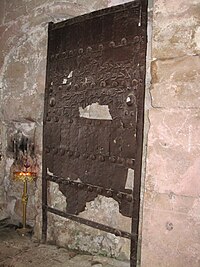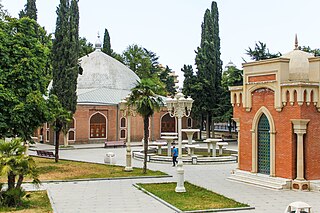 Gates of Ganja at Gelati | |
 | |
| Location | Gelati Monastery, Georgia |
|---|---|
| Completion date | 1063 |
The Ancient Gates of Ganja were a masterpiece of craftsmanship of the 10th to 11th centuries.
 Gates of Ganja at Gelati | |
 | |
| Location | Gelati Monastery, Georgia |
|---|---|
| Completion date | 1063 |
The Ancient Gates of Ganja were a masterpiece of craftsmanship of the 10th to 11th centuries.
In 1063, Shavur I, ruler of the Shaddadids dynasty, decided to build a castle surrounding Ganja. Six large gates were erected in different directions of the town. Upon Shavur's order Azerbaijani master Ibrahim ibn Osman built the gates. The gates were of cast iron decorated on the outside with stamped ornaments and patterns made according to the chasing method.
The ornament contained the name of the master in the Kufi language and the date of the gate's completion. The inscriptions in Kufi Arabic on the surviving leaf of the gate read: "With the name of Allah, the merciful and benevolent. The Excellency Sayyid Shawur ibn Al-Fazl - May Allah keep his supremacy longer! - ordered this door to be built with the help of Abul Faraj Muhammad ibn Abdulla - Let Allah give success to him too. Smith Ibrahim ibn Osman Angaveyh's work. (1063)". [1] [2] [3] [4] [5]
In 1139 a strong earthquake struck Ganja and practically destroyed the city. The earthquake was so strong that top part of Mount Kapaz to the south-west of the town broke off and fell down into the Aghsu River and created Lake Göygöl and other small lakes. King Demetrius I of Georgia took advantage of the earthquake to attack and loot the defenseless Ganja. He captured the gates as his trophy. The surviving citizens of Ganja carried the gates—weighing tons—on their backs.
Only one half of the gate has survived. It is built into the wall of Gelati Monastery across from the tomb of Georgian King David IV. [6] [7] Today, a leaf of this gate is fastened to the wall facing David I's grave in the yard of the monastery. [8] [9] [10]

Bartholomew was one of the twelve apostles of Jesus according to the New Testament. Most scholars today identify Bartholomew as Nathanael, who appears in the Gospel of John.
Articles related to the Azerbaijan Republic include:

Ganja is Azerbaijan's third largest city, with a population of around 335,600. The city has been a historic and cultural center throughout most of its existence. It was the capital of the Ganja Khanate until 1804; after Qajar Iran ceded it to the Russian Empire following the Treaty of Gulistan in 1813, it became part of the administrative divisions of the Georgia Governorate, Georgia-Imeretia Governorate, Tiflis Governorate, and Elizavetpol Governorate. Following the dissolution of the Russian Empire and the Transcaucasian Democratic Federative Republic, it became a part of the Azerbaijan Democratic Republic, followed by Azerbaijan SSR, and, since 1991, the Republic of Azerbaijan.

The Shaddadids were a Sunni Muslim dynasty of Kurdish origin. who ruled in various parts of Armenia and Arran from 951 to 1199 AD. They were established in Dvin. Through their long tenure in Armenia, they often intermarried with the Bagratuni royal family of Armenia.

Momine Khatun Mausoleum is a mausoleum, also known as the Atabek Dome, located in the city of Nakhchivan of the Nakhchivan Autonomous Republic in Azerbaijan. It was built in 1186 by the architect Ajami ibn Abubekr Nakhchivani. The ten-sided mausoleum reached a height of 34 meters. Today its height is only 25 meters. The mausoleum, built and named after the mother of one of the local rulers of Azerbaijan, Atabek Jahan Pahlavan of Ildegezid dynasty, is masterfully decorated with complex geometric ornaments and inscriptions from Koran.

Abu'l-Aswar or Abu'l-Asvar Shavur ibn Fadl ibn Muhammad ibn Shaddad was a member of the Shaddadid dynasty. Between 1049 and 1067 he was the eighth Shaddadid ruler of Arran from Ganja. Prior to that, he ruled the city of Dvin from 1022 as an autonomous lord. A capable warrior, and a wise and cunning ruler, Abu'l-Aswar was engaged in several conflicts with most of his neighbours.

The Taraggi Medal – is the state award of Azerbaijan Republic. The award was created by Heydar Aliyev, the President of the Republic of Azerbaijan, on December 6, 1993 by the Decree No. 758. Recipients of the award include Leyla Aliyeva, the daughter of Azerbaijan's ruler Ilham Aliyev and granddaughter of former ruler Heydar Aliyev.

Heydar Aliyev Order is the supreme order of Azerbaijan. The order was ratified by legislation of Azerbaijan Republic by the Decree No. 896-IIQ on 22 April 2005. The Heydar Aliyev Order is given to the citizens of the Republic of Azerbaijan for special contributions to the prosperity, greatness and glory of Azerbaijan; for courage and bravery displayed in defense of the Motherland and state interests of the Azerbaijan Republic. The Order is given to the President of Azerbaijan according to status.
The Imamzadeh Complex is an important Islamic site, located near Ganja, in Azerbaijan. The complex comprises a mausoleum that houses the grave of a prominent figure in Shia Islam, several mosques including the Goy Imam Mosque, a garden, gated walls, and various funerary monuments. Located 7 km (4.3 mi) north of Ganja, the complex is a shining example of Islamic architecture.
The Kasranids were a branch of the Shirvanshahs, who ruled the Shirvan region for 387 years. The word "Kasra" was derived from legendary king Kai Khosrow of Iran, reflecting a shift in naming tradition from Arabic to Persian and it was part of an effort to break with their Arabic roots by claiming to be successors of the Sasanians and the Kayanian dynasty.
Suleyman Aliyarli was an Azerbaijani historian, who wrote on a wide range of topics regarding the History of Azerbaijan; Professor of History at Baku State University.

Ganja State History-Ethnography Museum named after Nizami Ganjavi is the largest museum in Ganja,

Chokak Hamam is a historical bath near Juma Mosque in Ganja. Historical-architectural monument built in 1606, by order of Shah Abbas.

Ganja is the second largest city of Azerbaijan, according to its population (331.4 thousand, however, it is behind Baku and Sumqayit in terms of industrial production. The city is located in Ganja-Gazakh economic region. The economy of Ganja embraces the issues connected to the economy of the city of Ganja. Industry, tourism, agriculture, and transportation are the major branches of its economy. Most of the total volume of industrial products is accounted for non-ferrous metallurgy, light and food industries, electronics industry and home appliances.
In the history of Azerbaijan, the Early Middle Ages lasted from the 3rd to the 11th century. This period in the territories of today's Azerbaijan Republic began with the incorporation of these territories into the Sasanian Persian Empire in the 3rd century AD. Feudalism took shape in Azerbaijan in the Early Middle Ages. The territories of Caucasian Albania became an arena of wars between the Byzantine Empire and the Sassanid Empire. After the Sassanid Empire was felled by the Arab Caliphate, Albania also weakened and was overthrown in 705 AD by the Abbasid Caliphate under the name of Arran. As the control of the Arab Caliphate over the Caucasus region weakened, independent states began to emerge in the territory of Azerbaijan.
The High Middle Ages, or Classic Feudalism Period in what constitutes the present-day Republic of Azerbaijan, lasted from around the 11th century to the 15th century AD. The High Middle Ages were preceded by the Early Middle Ages and were followed by the Late Middle Ages, which ended around the 15thcentury AD. Key historical trends of the High Middle Ages include the incorporation of the territories that constitute present-day Azerbaijan into the Seljuk Empire, the establishment of the Eldiguzids, the Mongol invasions and the rule of the Ilkhanate, the invasions of Timur and the establishment of the Turkoman Kara Koyunlu and Aq Qoyunlu tribal confederations.
The 1139 Ganja earthquake was one of the worst seismic events in history. It affected the Seljuk Empire and the Kingdom of Georgia, in modern-day Azerbaijan and Georgia. The earthquake had an estimated magnitude of 7.7 MLH, 7.5 Ms and 7.0–7.3 Mw. A disputed death toll of 230,000–300,000 resulted from this event, making it one of the deadliest earthquakes ever recorded.
The Mongol invasions and conquests of the territory that now comprises the Republic of Azerbaijan took place during the 13th and 14th centuries and involved large-scale raids. The Mongol invasions of Azerbaijan resulted in the incorporation of the territories of what now comprises Azerbaijan into the newly established Hulagu state.

Shah Abbas Square is a square located in the historical center of the city of Ganja, Azerbaijan. At one time, it was the main memorial complex of the suburb of the Ganja fortress. The complex of Shah Abbas Square was firstly mentioned in the plan of the Ganja fortress of 1797. This architectural ensemble, located in the center of the suburb, consisted of a mosque, a bathhouse and other buildings.

Shah Abbas Caravanserai was built in Ganja by order of Shah Abbas. The caravansary was connected to Chokak Hamam and Shah Abbas Mosque by underground roads.